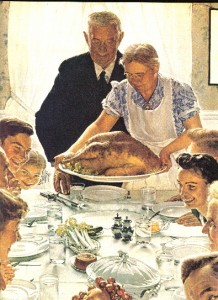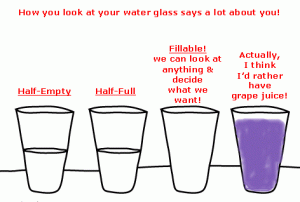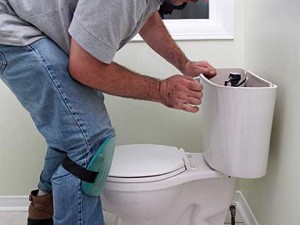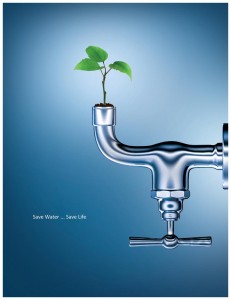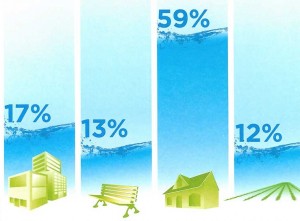Giving Thanks
November 30, 2010 by
Filed under Blog
A Season of Thankfulness
Thanksgiving is a time of historical significance to Americans, although over time, many of the details of the “First Thanksgiving” have been obscured or misrepresented. Nonetheless, regardless of the details, the pilgrim travails had been many, and the loss of family and friends grievous. Here’s a bit of history about the day of thankfulness! Indeed a time to share and give our blessings.
 According to William Bradford, governor of Plymouth and Plimoth Plantation (the site of that first Thanksgiving), “They began now to gather in the small harvest they had, and to fit up their houses and dwellings against winter, being all well recovered in health and strength and had all things in good plenty. For as some were thus employed in affairs abroad, others were exercised in fishing, about cod and bass and other fish, of which they took good store, of which every family had their portion. All the summer there was no want; and now began to come in store of fowl, as winter approached, of which this place did abound when they came first (but afterward decreased by degrees). And besides waterfowl there was great store of wild turkeys, of which they took many, besides venison, etc. Besides, they had about a peck of meal a week to a person, or now since harvest, Indian corn to that proportion. Which made many afterwards write so largely of their plenty here to their friends in England, which were not feigned but true reports.”
According to William Bradford, governor of Plymouth and Plimoth Plantation (the site of that first Thanksgiving), “They began now to gather in the small harvest they had, and to fit up their houses and dwellings against winter, being all well recovered in health and strength and had all things in good plenty. For as some were thus employed in affairs abroad, others were exercised in fishing, about cod and bass and other fish, of which they took good store, of which every family had their portion. All the summer there was no want; and now began to come in store of fowl, as winter approached, of which this place did abound when they came first (but afterward decreased by degrees). And besides waterfowl there was great store of wild turkeys, of which they took many, besides venison, etc. Besides, they had about a peck of meal a week to a person, or now since harvest, Indian corn to that proportion. Which made many afterwards write so largely of their plenty here to their friends in England, which were not feigned but true reports.”
The Pilgrims started constructing their living houses and storehouses in late December 1620, but only 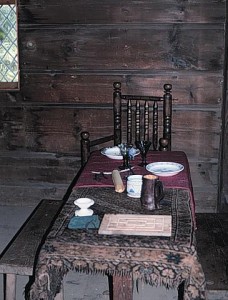 managed to get a couple built before and during the first winter; they were hindered further by occasional fires, usually caused by a spark or ember from the fire making it onto the roof, which was constructed of dried thatch. On 28 December 1620, the Pilgrims assigned plots to the 19 family groups, each family was responsible for building their own house, as well as supplying labor to build community storehouses and brick ovens for baking, a defensive fort, and sheds.They were assigned land plots that were 50 feet deep.The width of the lot was about 8 feet multiplied by the number of members in the family, so a family of six would have received a plot of land approximately 50 feet by 50 feet.In December 1621, Mayflower passenger Edward Winslow wrote a letter in which he said “we have built seven dwelling-houses, and four for the use of the plantation.”
managed to get a couple built before and during the first winter; they were hindered further by occasional fires, usually caused by a spark or ember from the fire making it onto the roof, which was constructed of dried thatch. On 28 December 1620, the Pilgrims assigned plots to the 19 family groups, each family was responsible for building their own house, as well as supplying labor to build community storehouses and brick ovens for baking, a defensive fort, and sheds.They were assigned land plots that were 50 feet deep.The width of the lot was about 8 feet multiplied by the number of members in the family, so a family of six would have received a plot of land approximately 50 feet by 50 feet.In December 1621, Mayflower passenger Edward Winslow wrote a letter in which he said “we have built seven dwelling-houses, and four for the use of the plantation.”
The houses on Plymouth Plantation were made out of logs, hay, rocks, wood and mud. Pilgrim houses were always one-room houses with an attic that had only ladder access. This one room was called the keeping room because it was, indeed, where all their belongings were kept. The entire family, and any servants present, ate, slept and lived in the keeping room. The keeping room had a fireplace where they cooked all their food and kept themselves warm.
 As we gather together, to ask for blessings on our families for the next year, and to give praise for the things for which we are grateful, our homes take center stage. Some of us may live in small homes, or studio apartments, but we did not have the burden of making the homes from a limited selection of materials, or suffering through a cold winter with inadequate insulation, and over-crowded conditions. Our homes, nowadays, are our refuge, the places where we go to recover from the onslaughts of the world, to be with our families and friends, and where we create individual places of peace and harmony. French philosopher Gaston Bachelard (1884 -1962,) once said, “If I were asked to name the chief benefit of the house, I should say: the house shelters daydreaming, the house protects the dreamer, the house allows one to dream in peace.“
As we gather together, to ask for blessings on our families for the next year, and to give praise for the things for which we are grateful, our homes take center stage. Some of us may live in small homes, or studio apartments, but we did not have the burden of making the homes from a limited selection of materials, or suffering through a cold winter with inadequate insulation, and over-crowded conditions. Our homes, nowadays, are our refuge, the places where we go to recover from the onslaughts of the world, to be with our families and friends, and where we create individual places of peace and harmony. French philosopher Gaston Bachelard (1884 -1962,) once said, “If I were asked to name the chief benefit of the house, I should say: the house shelters daydreaming, the house protects the dreamer, the house allows one to dream in peace.“
We give thanks for the homes that shelter us, protect us from the weather, encourage us to relax, dream and enjoy the things that are most important to us. We wish your family all the best of the season, and a home which shelters you physically as well as mentally.
?>How Full is YOUR Glass?
November 23, 2010 by
Filed under Blog
What is your Frame of Mind Regarding Household Fix-it’s?
Is your glass half-full or half-empty? This is an expression that I am sure you have heard, yet have you applied it to the things that you desire to have or create around your home? Do you look around your home and decide the project or desire is too big or lofty and walk away in despair? Or do you tolerate things that do not please because you just don’t have the time to change them or the money to do so? Then maybe you are looking at your glass as ‘half-empty!’
The idea that maybe, just maybe, we approach our home repairs, upgrades and changes as half-empty came to me when I received a timely email message on this very topic. (From Mary Morrissey, a Visionary & Empowerment Specialist.) She stated that for her, the best way to look at that glass is to tell yourself that “this glass is refillable!” Yes! I feel that way about a lot of things, especially home repairs and upkeep. It is important to care for our homes as we do our relationships; with joy, enthusiasm and an interest in creating the best we can of any situation.
Whether you own or rent, I suggest you ask yourself the following questions…
Are there fix-its that are essential to health and well-being that I need to attend to NOW?
Are there comfort issues that can be enhanced or fixed?
Are there upgrades that need doing that will reduce bills and be more efficient? (Low-flow toilets, for example, or energy efficient appliances.)
Are there petty annoyances that keep you from fully enjoying your home? Things like leaky windows, or frustratingly incomplete projects?
No worries! If your outlook on life expands to see the glass “refillable” then you can move forward, one step at a time, to have the home of your dreams. Here’s how.
 Decide what things must be done for safety or well-being. Then take a good look at your glass, and decide what you want to fill it with first!
Decide what things must be done for safety or well-being. Then take a good look at your glass, and decide what you want to fill it with first!
 In planning for fix-its or improvements, don’t go for the generic! A fillable glass means that YOU can fill it with whatever YOU want! Use dynamic colors of paint, chose textures that will caress your senses. The simple act of walking through a room can be a jarring, uncomfortable experience if you don’t have things the way you like them!
In planning for fix-its or improvements, don’t go for the generic! A fillable glass means that YOU can fill it with whatever YOU want! Use dynamic colors of paint, chose textures that will caress your senses. The simple act of walking through a room can be a jarring, uncomfortable experience if you don’t have things the way you like them!
 As with any project, a good plan will go a long way to get your glass filled. Set a time-line, discuss the financing of your projects with your partner and/or family, and be ready to take the steps necessary to move forward.
As with any project, a good plan will go a long way to get your glass filled. Set a time-line, discuss the financing of your projects with your partner and/or family, and be ready to take the steps necessary to move forward.
 It is always wise to be prepared for home improvements and fix-its. This means not only having the correct tools for the job, or having the right handyman to help, but being financially ready to take on the tasks.
It is always wise to be prepared for home improvements and fix-its. This means not only having the correct tools for the job, or having the right handyman to help, but being financially ready to take on the tasks.
 Think ahead.Be Proactive. Keep a logbook that lists the areas of your home that need repair, or that you want to redecorate. Make detailed notes on the condition and age of your appliances and fixtures (toilets, sinks, showers, baths etc.) including when repairs were done, when they were installed, etc. Then as you go through your lists to Prioritize, you will know what needs to be done, and when and where!
Think ahead.Be Proactive. Keep a logbook that lists the areas of your home that need repair, or that you want to redecorate. Make detailed notes on the condition and age of your appliances and fixtures (toilets, sinks, showers, baths etc.) including when repairs were done, when they were installed, etc. Then as you go through your lists to Prioritize, you will know what needs to be done, and when and where!
Last but not least, think about us! We are your go-to
Give us a call, email us, (925-432-7540) (The Fix-it Professionals Email). We can help you with your “Five P’s,” give you reasonable estimates for the work, and schedule your tasks in a decent time frame. The holidays are coming – how full is YOUR glass?
?>Do You Know the High Cost of Water Leaks?
November 16, 2010 by
Filed under Blog
What Can I Do to Reduce Them?
We recently helped a client whose water bills were insanely high.To her surprise and relief, it was a leak in her toilet, and an easy fix. Are your water bills creeping upward? Do you know where your main shut off valve is for your water? Do you know what to do in case of a pipe breakage or leak? The statistics are a bit alarming, but the problems generally are easily found and repairable. The key, as with many home repairs, is to be aware, be prepared and be proactive.
The amount of water wasted every year is truly appalling. In these time of cyclic drought and global warming, our water is a precious resource. Approximately 5 to 10 percent of American homes have water leaks that drip away 90 gallons a day or more! Many of these leaks reside in old fixtures such as leaky toilets and faucets. In fact, water lost by these leaky residences could be reduced by more than 30,000 gallons if new, efficient fixtures were installed. If the 5 percent of American homes that leak the most corrected those leaks-it could save more than 177 billion gallons of water annually! Yikes!
If all inefficient toilets in U.S. homes were converted to Low flow labeled models, we could save more than 640 billion gallons of water per year-the equivalent to 15 days of flow over Niagara Falls. Fixing easily corrected household water leaks can save homeowners more than 10 percent on their water bills. If you don’t feel you’re up to it, call someone like us to do it for you.
More alarming statistics:
 About 70% of the typical family’s indoor water usage is in the bathroom. This is partly because water is used at a faster “flow rate” in the bathroom than in any other part of the home. Toilets and showers usually have a flow rate of 5-7 gallons per minute; most dishwashers and clothes washers use less than three gallons per minute.
About 70% of the typical family’s indoor water usage is in the bathroom. This is partly because water is used at a faster “flow rate” in the bathroom than in any other part of the home. Toilets and showers usually have a flow rate of 5-7 gallons per minute; most dishwashers and clothes washers use less than three gallons per minute.
Toilet . . . . . . . . . . . . . . . . . . . . . . . . . 5 to 7 gallons per flush (Non high-efficiency toilet)
Shower . . . . . . . . . . . . . . . . . . . . . . . 5 to 7 gallons per minute (Non high-efficiency shower)
Bathtub . . . . . . . . . . . . . . . . . . . . . . . 36 to 60 gallons per bath
Dishwasher . . . . . . . . . . . . . . . . . . . . 10 to 25 gallons per cycle
Washing machine . . . . . . . . . . . . . . . 20 to 45 gallons per load
What can YOU do? First thing to do is to check your meter. Write down the numbers, and verify them with your current bill. The numbers should be near or GREATER than the numbers on your bill. If the numbers are lower than those shown on your bill, contact your water department; the meter may have been misread.
Meter not the problem? It is time to play detective! We have developed our own personalized Whole House Water Leak Testing Service. Designed and devised to check all the water-producing areas of your home, we can pinpoint the source(s) of leaks, and help you take steps to stop them. Contact us today, 925-432-7570 and let’s work together to get your high bills lowered!
Leaks not the problem? Then usage is. Practicing conservation in water use is both economically sound and ecologically appreciated! Water conservation has become an essential practice in all regions, even in areas where water seems abundant. In addition to saving money, conserving our water resources helps prevent water pollution in nearby lakes, rivers and local watersheds. It is important, for all of us! Sign up now, using our coupon, for your own Whole House Water Leak Testing, and receive our brief report, prepared to give you ideas on how and where to conserve water in your own home and yard.
 A popular saying when we were teens, found on bumper stickers and pins, was “Save Water, Shower with a Friend!” We all laughed, but that was the 1960’s and 1970’s, and now we are homeowners, parents, grandparents and stewards of the Earth, it is time to pay attention, rather than paying the piper! Join us in our conservation efforts.
A popular saying when we were teens, found on bumper stickers and pins, was “Save Water, Shower with a Friend!” We all laughed, but that was the 1960’s and 1970’s, and now we are homeowners, parents, grandparents and stewards of the Earth, it is time to pay attention, rather than paying the piper! Join us in our conservation efforts.
Modern Times – Modern Methods
November 9, 2010 by
Filed under Blog
Modern Times – Modern Methods
or…
Tried and True versus New
 There is an old proverb, supposedly Chinese in origin, that was said to be a curse: “May you live in interesting times.” Well, we certainly do! The last 60 years has been profoundly full of technological change, and modern marvels. Whether you live on the Steppes of Russia, (as these ladies do in this photo to the left might!) downtown Manhattan or suburban California, you are aware of, and probably use daily, all sorts of modern gizmos and labor saving devices!
There is an old proverb, supposedly Chinese in origin, that was said to be a curse: “May you live in interesting times.” Well, we certainly do! The last 60 years has been profoundly full of technological change, and modern marvels. Whether you live on the Steppes of Russia, (as these ladies do in this photo to the left might!) downtown Manhattan or suburban California, you are aware of, and probably use daily, all sorts of modern gizmos and labor saving devices! Yet,do you find your home reflects modern times or maybe more ancient ones? Do you prefer the tried and true, or are you loving the new technology?
Yet,do you find your home reflects modern times or maybe more ancient ones? Do you prefer the tried and true, or are you loving the new technology?
These are key questions to ask yourself ~ Does my home reflect my preferences in modern safety, design and comfort? Or is my decor outdated and unsuited to my lifestyle?
There ARE answers! Loving antiques and the soft patinas of past ages is not at issue here. What we’d like to focus on is making your home more reflective of you – livable, comfortable and desirable, inside and out. Yet, safety as we age, and as our homes age, is a key factor often overlooked. Whether you want modernistic, old world comfort, or art deco, there are a few things to consider when planning to freshen up, update and modernize your home.
- Are your windows or doors easy to open?
- Do you have poor lighting, especially in crucial areas like the bathrooms and kitchen?
- Are your floors safe to navigate, or do your floors have loose rugs, irregular floors and other tripping hazards?
- Are your tubs and showers easy to use, with comfortable access?
- Are your stairs (indoors or outdoors) made up of risers (width or height) that are easy to navigate?
- Are your appliances well placed, and easy to use?
- Do your rooms have a pleasant, easy layout, making them all the more usable?
With the methods and techniques now available to us, we can make improvements that help make our homes all they can be, without sacrificing our tried-and-true comforts. For example, newer technology in light bulbs makes it easier to be green AND safe at the same time. Home-sized Halogen, LED and CFL bulbs have incredibly long lives, and provide lighting that is easier on the eyes while providing less distorted vision. Battery and solar lighting makes it safer to light outside stairs, walkways and garden paths. So even if you love the ambiance of times gone by in your decor, you can display and use your special things safely and inexpensively.
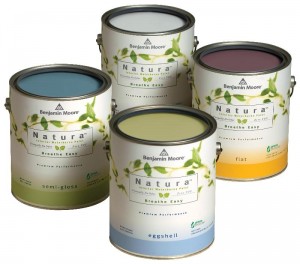 What about color? Is your home lacking it, all white or someone elses pick? If so, then another way to personalize or modernize can include the use of safe, green paint products to revitalize your rooms. Lead paints, used in the past, were horribly unsafe, and some paints from the 60’s and 70’s were thought to put off a gas residue for four years or so! You can buy paint today that does not put off noxious odors when used and that comes in an array of colors and hues. Is it time to freshen up your rooms with new paint and trim? Without replacing furniture or fixtures, you can create a new look for the holidays!
What about color? Is your home lacking it, all white or someone elses pick? If so, then another way to personalize or modernize can include the use of safe, green paint products to revitalize your rooms. Lead paints, used in the past, were horribly unsafe, and some paints from the 60’s and 70’s were thought to put off a gas residue for four years or so! You can buy paint today that does not put off noxious odors when used and that comes in an array of colors and hues. Is it time to freshen up your rooms with new paint and trim? Without replacing furniture or fixtures, you can create a new look for the holidays!
Owning a home, or even renting one, is extremely personal. Don’t live another minute tolerating a home environment that is not reflective of YOU! If you are a modern gal, then be sure your home reflects the modern woman that you are. Do not live with old furniture, outdated rugs, grandma’s hand-me-downs, broken things or delayed maintenance. A modern woman, after all, would not walk out of the house looking like that. So, why should your home be any different?
Here’s hoping that you continue to “live in interesting times” and be sure to get that makeover right away … of your home that is!
Change is in the Air ~ Are You Ready?
November 2, 2010 by
Filed under Blog
 No where is change more evident to us than in the change from summer to autumn. Even as we work at our careers, have busy, hectic lives and a ton of tasks to do, we see summer as a free-spirited time; time for fun, relaxation, being outdoors and being with friends and family. Autumn has a different feel, a different intent. It is time to slow down, to focus more on the inner workings of our lives. In this environment, change becomes more obvious – not only in the change in the weather (wasn’t that a doozy of a rainfall this weekend?!) but in the dynamic colors of fall leaves, in the scents drifting by on the wind, and the slow, measured honk of migrating geese.
No where is change more evident to us than in the change from summer to autumn. Even as we work at our careers, have busy, hectic lives and a ton of tasks to do, we see summer as a free-spirited time; time for fun, relaxation, being outdoors and being with friends and family. Autumn has a different feel, a different intent. It is time to slow down, to focus more on the inner workings of our lives. In this environment, change becomes more obvious – not only in the change in the weather (wasn’t that a doozy of a rainfall this weekend?!) but in the dynamic colors of fall leaves, in the scents drifting by on the wind, and the slow, measured honk of migrating geese.
How is your life changing these days? What things are you thinking about? Home repairs before the serious winter weather comes? Holiday parties and decorating? Time with family in front of an inviting fire? Is your home ready for the cooler days and special times you have planned?
Where do you start getting ready for Autumn and Winter with all the frolic and frenzy they may entail? Our number ONE recommendation is always: Take care of safety issues and potential problems first. Then you can enjoy the changes you bring to your home without worry.
We want you to be Warm … & Safe!
Here are a few ideas to help!
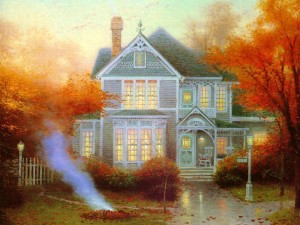 1. If you have a fireplace, or wood stove it is of crucial importance that you have them ready for the cooler weather. This entails cleaning out the chimney, especially if it hasn’t been done in a while, buying dry firewood, and going through old firewood that has been sitting in your yard for a year. It may be full of bugs, and rodents, wet weather may have created some mold, or lack of good air circulation may have made it likely to burn sodden and smoky. In today’s careful environment, there may also be restrictions on when you can have a fire lit. Be sure to check out your local regulations.
1. If you have a fireplace, or wood stove it is of crucial importance that you have them ready for the cooler weather. This entails cleaning out the chimney, especially if it hasn’t been done in a while, buying dry firewood, and going through old firewood that has been sitting in your yard for a year. It may be full of bugs, and rodents, wet weather may have created some mold, or lack of good air circulation may have made it likely to burn sodden and smoky. In today’s careful environment, there may also be restrictions on when you can have a fire lit. Be sure to check out your local regulations.
2. Local regulations also apply to burning leaves or yard waste, as MANY cities have stringent laws about outdoor burning, due to safety and smog concerns.
3. Last but not least, have your heater or Central Unit checked out for efficiency, pilot light problems (if you have one) and clean filters.
At The Fix-It Professionals we can help you with almost all your preparations for fall. We can recommend excellent craftspeople for tasks like chimney cleaning, and we can help you store your firewood, check your filters, and make sure your central heating is ready to use. Call for an appointment today, 925-432-7570.
?>
